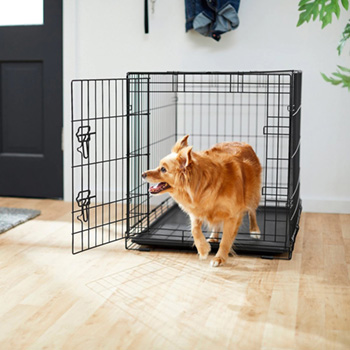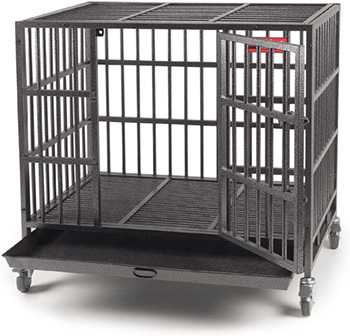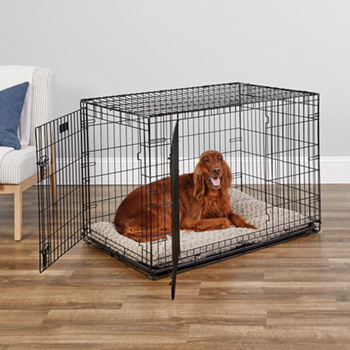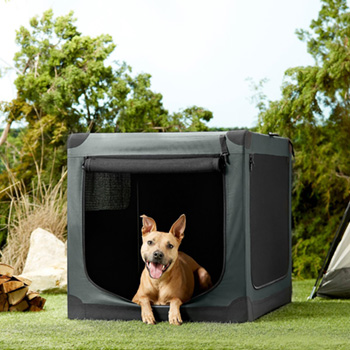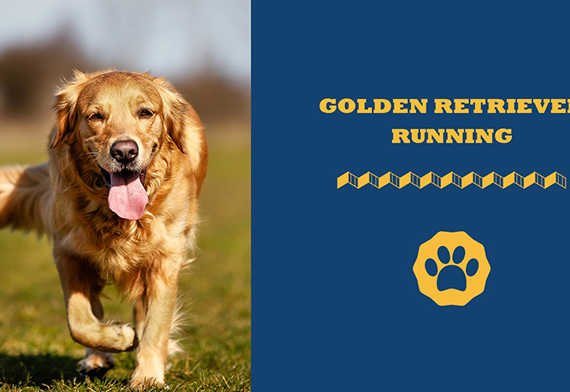This article contains affiliate links. Read the full disclosure here.
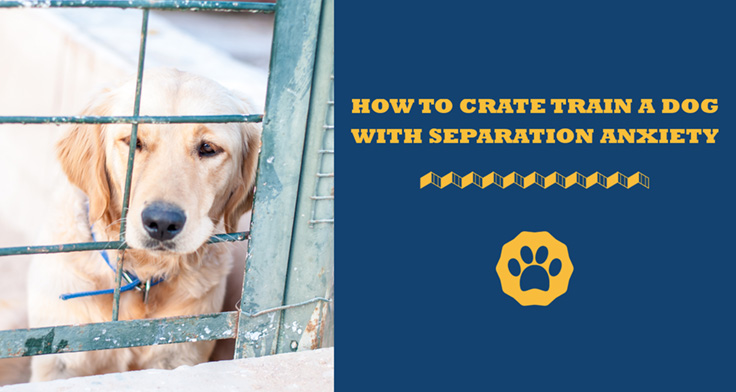
Crate training your dog with separation anxiety can go a long way toward reducing the fear they experience when they are left alone. This means that crate training can curb the ‘destructive bad behaviors’ that they may perform when left alone in the home.
It is important to remember that just buying a crate and putting your dog in it will not treat their separation anxiety or solve the problem at all. Treating their separation anxiety is a lengthy process that requires time and patience from you.
Dogs experience separation anxiety for a lot of the same reasons that humans do. We both fear changes in our surroundings, being left alone suddenly, and not understanding why things have to change or people have to leave.
Using a crate and going through the long (but rewarding) process of training your dog to reduce their fear of being left alone will help them enjoy their life more and reduce the amount of anxiety that you feel leaving them alone at home.
Some Helpful Products At A Glance
I have carefully considered what separation anxiety means to you and your dog and researched the best crates for different situations to suit your and your dog’s needs:
-
Frisco Fold & Carry Single Door Collapsible Wire Dog CrateBest Overall And Best Budget
-
ProSelect Empire CagesBest Premium
-
MidWest iCrate Fold & Carry Double Door Collapsible Wire Dog Crate
-
Frisco Indoor & Outdoor 3-Door Collapsible Soft-Sided Dog Pet Crate
-
New Age Pet EHHC 103L EcoFlex Habitat-n-Home Inn Place Crate/Table
| IMAGE | PRODUCT | ||
|---|---|---|---|
|
Best Overall And Best Budget
|
Best Overall And Best Budget
|
|
CHECK PRICE → |
|
Best Premium
|
Best Premium
|
|
CHECK PRICE → |
|
|
|
CHECK PRICE → | |
|
|
|
CHECK PRICE → | |
|
|
|
CHECK PRICE → |
Step-By-Step Guide: Crate Training A Dog Who Suffers From Separation Anxiety
According to the American Kennel Club, “separation anxiety is when your dog exhibits extreme stress from the time you leave him alone until you return. The symptoms can vary, but he will act as if he’s terrified to be in the house on his own.” Always be alert for this behavior.
Crate training a dog with separation anxiety is a long process that is going to require a lot of effort on your part; however, that effort will all be worth it once you have successfully managed your dog’s fears.
1. Choose Your Crate Carefully
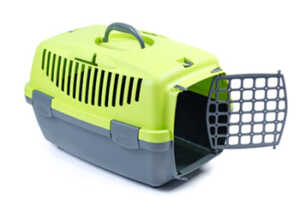
Picking the correct crate for your dog is important. Your dog should be able to stand up, extend its tail fully and have a good stretch inside its crate. If they cannot, their crate is too small. A too-small crate will enhance feelings of anxiety.
You also do not want a crate that is too large. If your crate is too large your dog can get a running start and bash its head into the side if it’s scared. Your dog’s crate should feel a bit like a cave or den, cozy and safe.
Your crate should have good ventilation whether it is a wire or closed panel one. Good airflow will help reduce odors and keep your dog feeling refreshed.
If the crate is made of wire or has bars on it and your pup can see outside, try draping a blanket over the top and sides at night to create a sense of enclosed space that is safe; however, if you find that your dog is constantly pulling the blanket through the bars, you will need to stop.
Your crate should be escape-proof to prevent your dog from getting up to mischief or getting hurt.
If you are using a wire crate, make sure the wires are covered by a rubber or plastic coating so they do not cut into your dog’s gums if it tries to chew them.
2. Make The Crate A Safe, Happy, And Familiar Place
Your dog’s crate should be a safe place that makes them feel secure and happy to reduce feelings of anxiety. Don’t shove old rags in the crate; your dog will just chew them. You wouldn’t want to sleep on a bed of rags and your dog shouldn’t either.
Get them a comfy bed or mattress that protects them from the cold base of the crate and put in one or two blankets that smell like you. This way, your dog will always be able to smell you and their crate will feel familiar which helps prevent separation anxiety attacks.
Toys are key! A bored dog is an anxiety-prone dog. Use a Kong or similar toy that is very tough and fill it with a couple of treats. This will keep your dog occupied both physically and mentally for a while.
For a simple puzzle game that should keep them occupied for up to an hour, follow these steps:
- Take a blanket and lay it flat
- Place a fair number of treats or some kibble all over it
- Slowly roll the blanket up, trapping the treats or kibble in the rolls
- Tie the ends of the blanket together pretzel-like
Your dog is going to use its brain and a number of its senses to figure out it needs to untie the blanket, unravel it, and hunt for all of the treats. This is an exhausting process for them which is a good thing! They are occupied and do not have time to feel the pain of separation. You can even use calming treats that will further help relieve your dog’s anxiety or stress.
3. Desensitize Your Dog To Your Leaving Procedure
We all have a procedure that we follow when we get ready to leave the house.
For example:
- Put on shoes
- Pack handbag/pick up wallet
- Pick up keys
- Check the windows/backdoor
- Put on alarm
- Pet dog
- Leave
Your dog is clued into that leaving process and they will learn to anticipate being alone for long periods of time when you initiate that process.
The longest part of the crate training procedure and treating separation anxiety is desensitizing your dog to this procedure.
At least twice a day for 5 to 10 minutes at a time, go through your leaving procedure and then go do something else in the house like sit down at your computer, get into bed, watch some TV, or make a cup of tea.
You will know that your dog is becoming desensitized when they no longer follow you around through this procedure.
Start to incorporate putting them in their crate now; however, don’t leave your home yet. Sit down next to them or watch TV so they don’t feel as though they have been abandoned.
Once your dog is able to be in their crate without whining, barking, or pacing while you are home or going through the process of leaving home, you know they are not anticipating your departure.
4. Couple Leaving And Arriving Commands
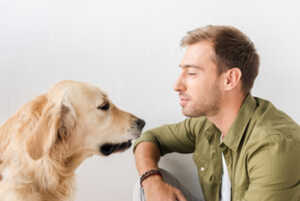
Dogs are smart and they pick up on verbal cues. ‘Sit,’ ‘lay down,’ ‘stay,’ and ‘crate’ should all be commands your dog learns at a young age.
They know that if you say ‘bye my baby!’ that you are leaving. They also know the sounds of your arrival and phrases like ‘hello my boy, I’m home’ mean that you are there to stay.
Start coupling your leaving and arrival commands together. ‘By my boy, I’ll be home soon,’ means that you are leaving but also coming back, which reduces their anxiety.
5. Do Not Hype Up Your Arrival Or Departure
Nothing brings me more joy than rushing to my pup when I get home at the end of a long day at work and giving them scratches and cuddles. Unfortunately, your dog gets hyped up by this behavior.
Before I leave for work I always make a point of giving them a goodbye cuddle just to make sure they know I will miss them. If your dog doesn’t have separation anxiety, there is nothing wrong with this.
If they suffer from separation anxiety, hyping up your leaving and arrival will trigger them.
Calmly leave and enter the house through as many access points as you have. If you know that you usually leave through the backdoor, use the front door and change it up often.
6. Exercise And Puzzles Are Key
When you are home, exercise your dog at least once a day for 15 to 30 minutes by going for a walk, a run, or simply playing actively with them. If they are physically engaged throughout the week, they will have less anxious energy built up and ready to be triggered by separation.
As I mentioned previously, puzzles and toys help keep your dog mentally engaged too. If they are engaged in solving puzzles, they will be too tired to realize you ever left!
7. Never Discipline Them For Anxious Behavior
Coming home to chewed up carpets and beds, ripped up toys, or messes is incredibly frustrating; however, punishing your dog for them will do you no good and will, in fact, make the situation worse.
Your dog will not connect the punishment with the destructive behavior.
8. Patience And Practice
It is very unfortunate that many owners give up on their pups because of destructive behavior that is a direct result of separation anxiety.
Think of a toddler throwing a tantrum because they do not understand why Mommy has to leave them at daycare. Eventually, with consistent work and a lot of patience, daycare becomes a safe and happy place and it is okay for Mommy to leave them there for a couple of hours.
A parent wouldn’t abandon a child because they throw tantrums. Dogs do not always get the same consideration.
Many owners get sick and tired of cleaning up messes, replacing dog beds, explaining why there are scratch marks on the doors, or the carpet is chewed up, and they abandon or surrender their dogs. These dogs are then labeled as problem dogs and often do not get adopted again.
Crate training them and treating their separation anxiety will take a long time and a lot of patience but it can be done! If you are finding that their anxious behaviors are not changing, consult your vet or a behavioral specialist for help.
9. Use The Crate For More Than Just Separation Anxiety
Don’t only use the crate when you leave home. The crate should be open and accessible when you are home, too, so your dog knows it is still a safe place and not a punishment.
Sit next to the crate or place it in a family living area so that your dog can be in its safe place with you around.
How Is Crate Training Different For Puppies?
Puppies do not take a long time to learn crate training. If you stick to their schedule and their training once they pick up the behavior, it will become second nature to them.
Crate training a puppy is slightly different, though, and you will need to know in what situations you should avoid crating them. Successfully crate training a puppy can also prevent separation anxiety from developing later in life.
How Is Crate Training Different For A Rescue Dog Who Suffers From Separation Anxiety?
Rescue dogs suffer from abandonment issues. They will be incredibly reluctant to use a crate if they associate it with your absence. The process of crate training them will be long and difficult.
Make sure their crate feels like home and safety, and that you use it when you’re home so they don’t feel like it’s a punishment.
FAQs About Crate Training A Dog With Separation Anxiety
Can any breed of dog be crate trained?
Any breed of dog can be crate trained. Some breeds, like golden retrievers, are particularly susceptible to separation anxiety due to their sociable nature. It is advisable to crate train them from the time they are puppies.
Can Crate Training Help With Separation Anxiety?
As I mentioned previously, simply putting your dog suffering from separation anxiety in a crate is cruel and often dangerous for your dog. Dogs that are having separation anxiety attacks will try to chew and claw their way out of their crate if they have not been trained properly.
This leads to broken teeth, bleeding gums, ripped-up nail beds and paws, and a dog that is learning to fear and hate its new crate.
Carefully going through the correct steps of crate training your dog with separation anxiety can eventually help treat the problem. Effectively crating your dog from the time they are a puppy can even help to prevent separation anxiety altogether!
Can I crate train my dog if I have a full-time job?
You can crate train your dog even if you work full time! Check out this post to see how you can do it.
Calmly Wagging Away…
Crate training a dog with separation anxiety is a long process that is going to take a lot of patience from you. You can’t simply put them in a crate and think the problem is solved.
Using crate training in addition to treating their separation anxiety is key to solving the problem and creating a home that is a safe and happy place for your dog and you.

